Some game series have success right out of the gate. Some series have a slow start as they emerge from humble beginnings. Then there are series like Shantae, where almost every game is funded out of the pocket of the developers, and nearly three console generations and 10 years of time separate the first and second installments.
Today we talk about the Shantae series; A series of platformer video games with a truly admirable tale of dedication attached to its creation and its duration in the tossing tides of the video game industry.
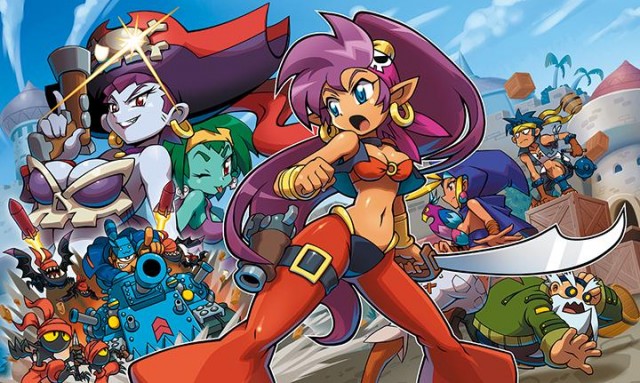
Let’s start at the beginning, a very good place to start.
Shantae was the first original IP by developer WayForward Technologies, and it was co-created by now-married couple Erin Bell and Matt Bozon. The story goes that Bozon was conversing with Bell about what sort of character she’d like to make if she were to design a video game character. Some time soon after, Matt discovered Erin drawing up concept sketches of the heroine.
Matt began asking about what Shantae’s abilities would be, as well as her personality and the world she lived in — After some discussion between the couple over character and world details the purple-haired warrior maiden was born.
The design of both Shantae and her world were influenced by inspirations of both Bozon and Bell.
Shantae’s name and long hair came from Erin’s personal experience. She had been working as a camp counselor up until that point, and one of the campers she had worked with had been named Shantae, a name Bell grew fond of. It has also been stated by Matt that Erin had very long hair at the time, which would often whack him in the face whenever she turned around, which is where Shantae got her signature look and signature attack of whipping her hair. Erin was also inspired by the television show I Dream of Jeannie.
Matt’s influences came in the shape of outside sources that inspired the gameplay style and feel of Shantae’s world. The gameplay was heavily inspired by The Legend of Zelda, Castlevania, and Mega Man, as can be seen in the Metroidvania structure as well as her range of abilities.
Matt’s ideas for the art style and aesthetic was inspired by cartoons like Ducktales and Transformers (properties WayForward would actually go on to make games for later on). Further inspiration came from anime like Ranma 1/2 and the works of Hayao Miyazaki.
Matt Bozon is quick to clarify that he did not create Shantae, but rather his wife did. While he created the world around her and fleshed out characters. Both the Bozons were integral in the creation of the series and Erin Bell (now Erin Bozon) is Shantae’s creator.
The development of the first Shantae began in 1997, and was originally conceived as a 2D platformer with animated characters moving along 3D backgrounds, made for release on PC, and perhaps the original PlayStation — This version was scrapped early on, and development focus shifted to the Game Boy Color from then on, based on a decision by WayForward founder and “tyrannical overlord” Voldi Way.
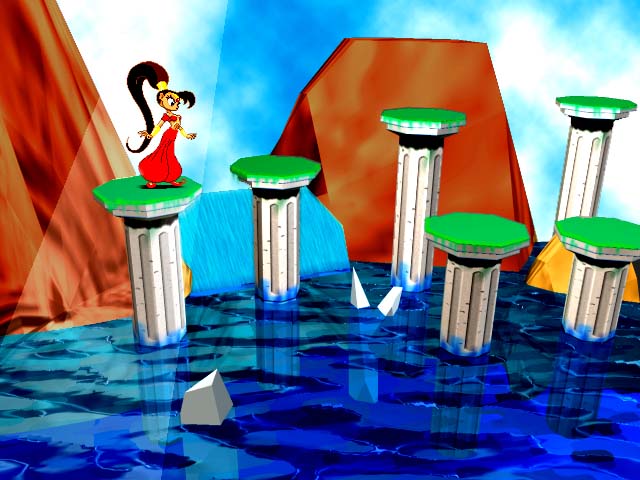
An early and unpolished screenshot of the abandoned attempt of Shantae on the PlayStation/PC.
Although Shantae began development in 1997, it would not see a proper release until 2002, nearly an entire year after the new Game Boy Advance had been on the market.
This is where it gets messy.
The development and publishing process of the original Shantae is a ludicrous, though thankfully well-documented disaster. Through a number of different interviews with Matt Bozon, it has been made clear how many difficulties both he and WayForward faced in getting the game made.
During development, the team’s computers had to have buckets of ice put inside them at times to stop them from overheating in the California heat. Matt Bozon has even reported that the Game Boy Color Development Kit he had to work with was Japanese — Meaning he had to make his own personal cheat sheet to remember what button did what function.
But despite all these hardships Shantae was eventually finished and ready for the world to see… but not quite yet. This was when WayForward ran into their next big hurdle; finding Shantae a publisher.
In order to run properly as well as save progress, Shantae required each cartridge to be built with a 32 megabit battery, which was expensive to produce and turned a lot of publishers off. On top of this, most publishers saw launching a game with a new intellectual property as an additional risk. Luckily, this response didn’t stop the team from trying to get the game published, and their perseverance paid off when they finally acquired a publisher in the form of Capcom.
Unfortunately, the game’s final step in publication also came with problems. For reasons that have never been fully explained, even though Capcom was the only publisher who would pick up Shantae — the company held the completed version of the game in storage for 8 months before releasing it.
The game would have still released late for the Game Boy Color if it had been released right away, but due to the 8 month delay, Shantae released nearly an entire year after the then-new Game Boy Advance had been out, which ultimately lead to it under-performing in sales.
So on June 2nd, 2002 Shantae on the Game Boy Color finally saw the light of day… exclusively in North America where it sold only around 25,000 copies with no second print produced (…ouch).
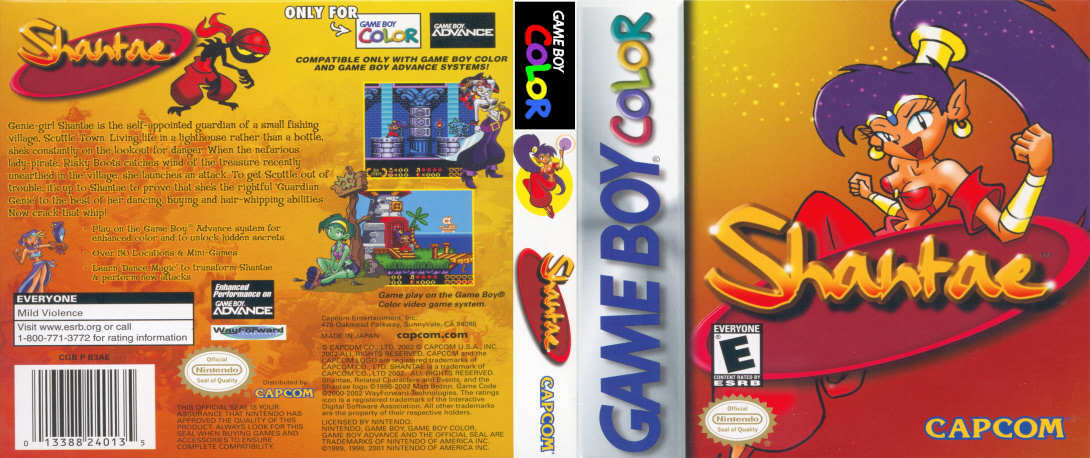 Front and back cover of the original Shantae on the Game Boy Color.
Front and back cover of the original Shantae on the Game Boy Color.
The quest for sequels!
While the first Shantae sold pretty poorly, it was received very positively by critics, and Matt Bozon and the rest of WayForward weren’t discouraged enough to stop trying. Shantae would resurface years later with the announcement of a sequel to the original game dubbed Shantae Advance (also known as Shantae 2: Risky Revolution) meant for release on the Game Boy Advance.
The game was supposedly meant to feature a number of features. There was six new towns to visit, four new labyrinths to explore based on the four seasons, various minigames, new transformations, swimming, flying, the ability to jump between the background and foreground.
The plot also revolved around Risky Boots sticking a giant pillar in the middle of Sequin Land in order to completely rotate it at will. Unfortunately, WayForward once again had difficulties finding a publisher, and Capcom wasn’t there to bail them out this time — so the game was ultimately cancelled.
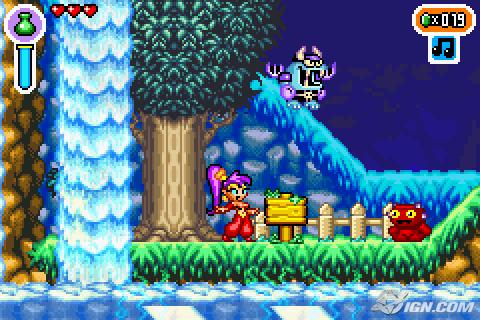
Early screenshot of what would have been Shantae Advance. Image credit to IGN.com.
(For those interested in seeing what exists of the game, click here to see an archive of a live stream WayForward had of the game’s most finished build.)
Some time after that there was also supposedly a short-lived plan for a DS Shantae game titled Shantae: Risky Waters. The game had a basic design document laid out, but after once again failing to find a publisher, the game was cancelled just like Shantae Advance.
Just when it seemed like Shantae as a series might just disappear, in 2010, WayForward pulled it out of their hat by finally releasing a sequel to the first game titled Shantae: Risky’s Revenge, release for DSiWare.
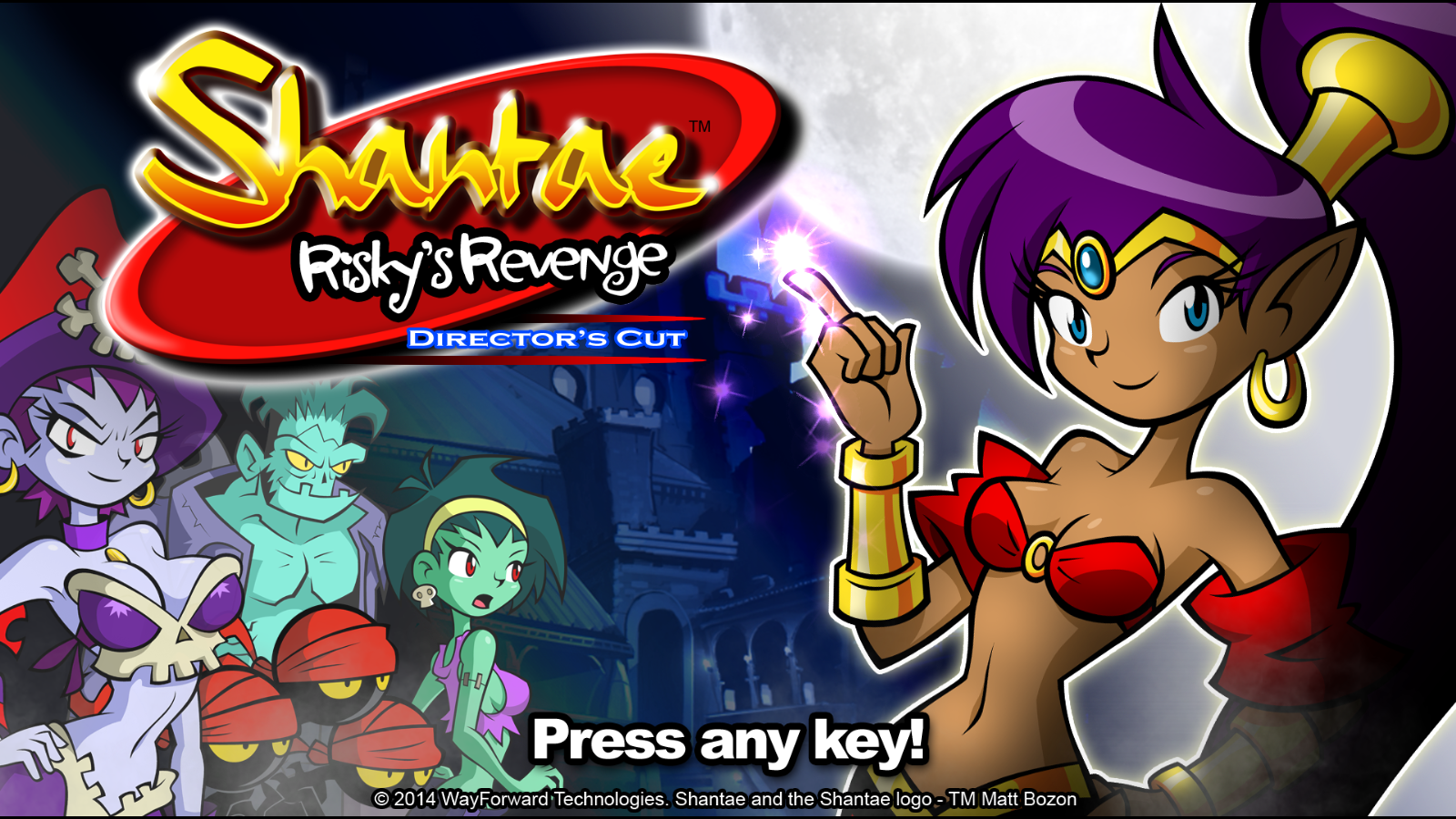 Title screen for the Director’s Cut improved version of Risky’s Revenge that released on PC a few years later.
Title screen for the Director’s Cut improved version of Risky’s Revenge that released on PC a few years later.
Risky’s Revenge, much like the first Shantae, had a few hiccups during development, but not nearly as much. Several ideas from the cancelled Shantae Advance made it into the final game, including swimming and jumping between background and foreground feature and some plot points, although it is hard to say how much.
The biggest change that occurred in development was that the game was originally meant to be a three part episodic series available for download. The final game was a single stand alone release, possibly due to budget or time constraints. Despite all this, Risky’s Revenge did very well critically just like the first game, and is often cited as the best DSiWare game available.
By this time, due to the growing power of the internet and it now being a series, the brand awareness of Shantae began to grow much larger than it had been. While DSiWare titles weren’t know to sell well, Risky’s Revenge did better than most, and gained an added boost by being available on the 3DS eShop early in it’s life.
As a result of their newfound success, WayForward didn’t need to gather their resources for nearly 9 years to make a sequel, and managed to make another in only half the time.
Pirate’s Curse brings the series some well-deserved booty.
By this time, WayForward had finally become a recognizable name in the industry, after gaining praise and attention for their far-above average licensed games like DuckTales: Remastered, their Adventure Time games, and Aliens: Infestation. Not to mention their growing catalog of acclaimed original title like Mighty Switch Force 1 & 2, Double Dragon Neon, and their remake of A Boy and His Blob.
WayForward had a resume, they had a reputation, and they had money. They had all the things needed to make a brand new Shantae game that wasn’t nearly restricted as the ones prior and that’s exactly what they did.
In 2014, WayForward released the third, and newest installment in the series Shantae and the Pirate’s Curse. The game was initially announced in November of 2012, in one of the most stylish ways possible, by taking up the cover of the penultimate issue of famed gaming magazine Nintendo Power.
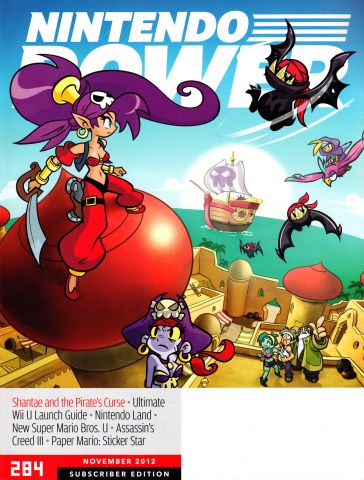
Now THAT is prime advertising space.
The game was first released for download on the 3DS in North America, where it enjoyed an even better commercial and critical response than Risky’s Revenge. Over time it went on to be a best seller on the system.
#Shantae and the #PiratesCurse is on the Best Sellers for Nintendo eShop 3DS!
Join the fun! http://t.co/gm2KuC6Ae6 pic.twitter.com/ro6MxHR6qu— WayForward (@WayForward) February 27, 2015
Fast forward two years and Pirate’s Curse is available nearly everywhere and not just in places other than Northern America, but on nearly every system available. WayForward has ported the game to Wii U, XBox One, Playstation 4, Steam, GOG.com, and even the Amazon Fire TV at this point — Shantae and the Pirate’s Curse slowly became the best kind of success WayForward could have hoped for: A widespread success.
Shantae’s story still continues on…
Following a successful Kickstarter campaign in 2013 during Pirate’s Curse’s development, Shantae: Half-Genie Hero is currently in development, and is planned for release on September 27 of this year.
The game is the first in the series to be built from the ground up for consoles, and will feature fully hand-drawn animations. The game will have new transformations for the heroine and thanks to it’s campaign reaching it’s $900,000 stretch goal, it’ll include four additional characters with their own playable campaigns as well.
(on a side note: of all the things that show how far Shantae as a series has come, the original trailer for half-Genie Hero’s Kickstarter does it the best.)
Shantae is officially a series now, and it seems to be growing bigger and more beloved faster than it ever has before. Technology has only improved these games, as has better funding for WayForward, but what really kept this series alive and improving was heart. From the imaginative developers and dedicated fans, Shantae has been kept alive by love for a character and her world — It’s truly inspiring to see such a success story come from a battle of attrition fought by people who used to be nobodies in the industry.
Whatever plans that Matt Bozon and the rest of WayForward Technologies have for Shantae following Half-Genie Hero are unclear as of now, but as long as the fans are there, they’ll all be Ret-2-Go!








Published: Aug 28, 2016 06:37 pm